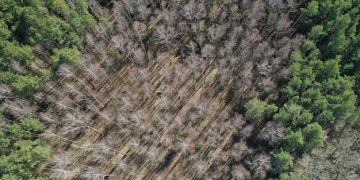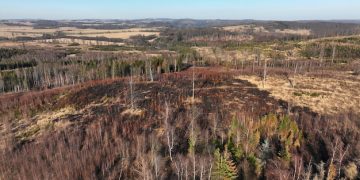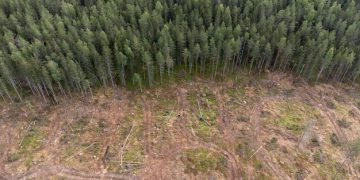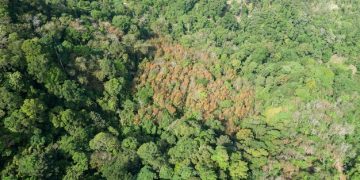US Lumber Demand & Deforestation: 2025 Impacts Explored
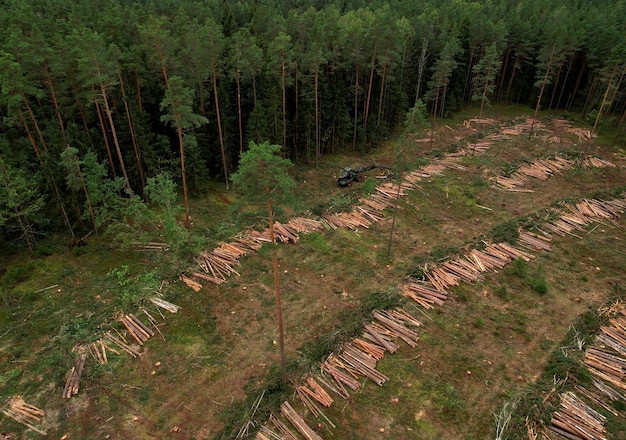
The projected 15% increase in US lumber demand by 2025 is set to intensify deforestation impacts, exerting mounting pressure on global forests and demanding urgent reevaluation of sustainable sourcing and timber management to mitigate significant ecological and climate consequences.
The intricate relationship between lumber demand and deforestation is a pressing global concern, one that is poised for significant acceleration. With a projected 15% increase in US lumber demand by 2025, the implications for forest ecosystems worldwide are profound. This isn’t merely an economic forecast; it’s a critical environmental crossroads that requires a deep dive into its potential ramifications.
The Looming Demand Increase: What Drives It?
The United States, a prominent consumer of timber products, faces a projected 15% surge in lumber demand by 2025. This isn’t an isolated phenomenon; rather, it’s a confluence of several macro and microeconomic factors contributing to an escalating need for wood across various sectors. Understanding these underlying drivers is crucial for anticipating and addressing the environmental consequences that may follow. The growth in construction, fueled by demographic shifts and economic recovery, plays a significant role here.
Residential Construction Boom
A primary catalyst for increased lumber demand is the robust activity within the residential construction sector. The housing market, particularly single-family homes, requires substantial quantities of lumber for framing, roofing, and interior finishes. An expanding population, coupled with evolving housing preferences and a persistent shortage of affordable homes, continues to drive new construction projects. This creates a direct correlation between housing starts and the volume of wood required by the market.
- Population Growth: A steadily growing US population necessitates more housing units.
- Low Interest Rates (Historical Impact): Historically low interest rates have incentivized home-buying and new construction.
- Millennial Homeownership: The largest demographic cohort, millennials, are increasingly entering the homeownership market, driving demand.
- “Work From Home” Trends: Increased time spent at home has sparked renovations and expansions, further consuming lumber.
Commercial and Infrastructure Development
Beyond residential needs, commercial construction and infrastructure projects also contribute significantly to the overall demand for lumber. While often overshadowed by housing, the construction of office buildings, retail spaces, warehouses, and public infrastructure such as bridges and boardwalks still relies on wood products. As economic activity rebounds and investment in infrastructure increases, so too does the call for timber. This broader development picture adds another layer to the complex demand equation.
The supply chain for lumber is also a critical consideration. Disruptions caused by global events, alongside shifts in trade policies, can exacerbate demand pressures on domestic and international forests. The dynamic interplay of these factors paints a clear picture of an impending increase in timber consumption in the US.
Direct Consequences: Intensified Deforestation
A 15% increase in US lumber demand by 2025 inevitably translates into intensified pressure on forests, both domestically and internationally. Deforestation, the clearing of forested land for other uses, is a direct consequence of this heightened demand, leading to a cascade of ecological, social, and economic impacts. The scale of this demand suggests an acceleration of forest loss, challenging current conservation efforts and sustainable forestry practices.
The urgency to meet this demand often results in unsustainable logging practices. Forests are not just sources of timber; they are complex ecosystems providing vital services. Increased exploitation risks disrupting these delicate balances.
Loss of Biodiversity Hotspots
Forests, especially old-growth and primary forests, are biodiversity hotspots, harboring countless species of plants, animals, and microorganisms. Accelerated deforestation to meet lumber demand directly threatens these ecosystems, leading to habitat fragmentation, species displacement, and potential extinctions. The loss of these unique environments diminishes the planet’s overall biodiversity, impacting ecological resilience and ecosystem services.
The removal of tree cover also affects local climate patterns and soil stability. Without trees, soil erosion increases, leading to degraded land and reduced agricultural productivity. This chain reaction underscores the extensive reach of deforestation beyond just the absence of trees.
Increased Carbon Emissions
Forests act as crucial carbon sinks, absorbing vast quantities of carbon dioxide from the atmosphere. Deforestation not only releases the stored carbon back into the atmosphere through decomposition or burning but also reduces the planet’s capacity to absorb future emissions. The projected increase in US lumber demand could significantly amplify this effect, contributing to global warming and climate change, making it harder to meet international climate goals.
- Reduced Carbon Sequestration: Fewer trees mean less CO2 taken from the atmosphere.
- Emissions from Logging: The process of logging, transport, and processing timber also contributes to greenhouse gas emissions.
- Forest Fires: Degraded forests are often more susceptible to large-scale fires, releasing massive amounts of stored carbon.
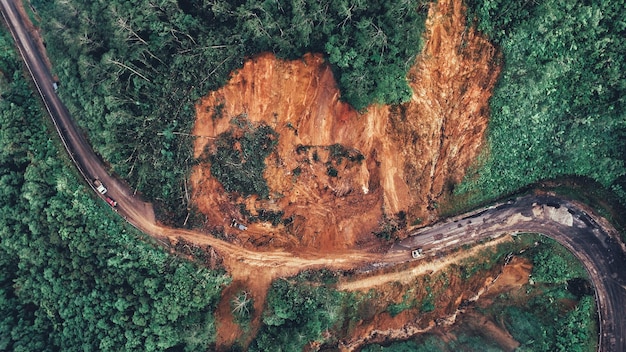
The pressure isn’t just on natural forests. Plantation forests, while a source of timber, do not offer the same ecological benefits as natural forests, often being monocultures that support less biodiversity and contribute less to carbon sequestration. The shift towards increased timber harvesting, regardless of its source, requires careful oversight to prevent irreversible environmental damage.
Strain on Global Forest Resources
The US is a significant player in the global timber market, importing lumber from various countries. A domestic increase in demand will not be met solely by US forests; it invariably translates into increased pressure on international forest resources, particularly in regions with less stringent environmental regulations or weaker enforcement. This global interconnection of supply chains means that US consumption habits have far-reaching ecological implications.
Illegal Logging and Unregulated Markets
Heightened demand can fuel illegal logging activities in countries where governance is weak, and oversight is scarce. Unregulated markets offer cheaper timber, tempting buyers looking to cut costs, but at a devastating environmental and social price. Illegal logging contributes directly to deforestation, often bypassing environmental impact assessments, labor laws, and indigenous land rights. This also makes it incredibly difficult to track the true origin and sustainability of wood products.
The illicit timber trade is a complex web, often linked to organized crime and corruption. It undermines legal and sustainable forestry operations and can lead to severe damage to pristine forests, which are invaluable for biodiversity and climate regulation. Consumers in the US often unknowingly become part of this problem, highlighting the need for greater transparency and due diligence in supply chains.
Vulnerability of Tropical Forests
Tropical forests, already under immense pressure from agriculture, mining, and other land uses, are particularly vulnerable to increased timber demand. Countries in Southeast Asia, Africa, and South America are major sources of timber, and a surge in global demand could push these delicate ecosystems past their tipping point. These forests are vital for global climate regulation and support exceptional levels of biodiversity, making their destruction an irreparable loss.
- Biodiversity Collapse: Tropical forests house over half the world’s plant and animal species; deforestation here leads to rapid species loss.
- Indigenous Community Displacement: Logging often displaces indigenous communities who depend on forests for their livelihoods and culture.
- Climate Feedback Loops: Loss of tropical forests can exacerbate regional droughts and global warming, creating dangerous feedback loops.
Addressing this global strain requires a multi-faceted approach, involving international cooperation, strengthening of environmental laws, and consumer awareness. The interconnectedness of global ecosystems means that local demand in the US has ripple effects across the planet.
Economic and Social Repercussions
The intensification of deforestation impacts due to increased lumber demand extends beyond environmental degradation; it also carries significant economic and social repercussions. These consequences affect local communities, national economies, and global trade dynamics, creating a complex web of challenges that demand thoughtful and comprehensive solutions.
Impact on Local Communities
Forest-dependent communities, particularly indigenous populations, are often at the frontline of deforestation impacts. Their livelihoods, cultural heritage, and traditional knowledge are intrinsically linked to healthy forest ecosystems. Increased logging can lead to displacement, loss of traditional lands, and disruption of food sources, exacerbating poverty and social instability. The long-term costs of disturbing these communities often go unrecognized in short-term economic gains.
Moreover, the degradation of forests can lead to a scarcity of resources that these communities rely on for daily survival, such as clean water, non-timber forest products, and fertile soil for agriculture. This can ignite social conflicts and force migration, creating further humanitarian crises. The human element of deforestation is often overlooked but profoundly important.
Disruption of Ecosystem Services
Healthy forests provide invaluable ecosystem services, including water purification, soil stabilization, regulation of local climates, and pollination. Deforestation diminishes these services, leading to downstream economic costs. For example, increased soil erosion can clog waterways, requiring costly dredging, and reducing agricultural productivity. Loss of natural flood barriers can heighten the risk of devastating floods, impacting infrastructure and human settlements.
- Water Quality Decline: Forests filter water; their removal leads to increased sediment and pollutants in water sources.
- Increased Natural Disasters: Loss of tree cover can amplify the severity of mudslides, floods, and droughts.
- Reduced Agricultural Yields: Degraded soil and altered local climates negatively affect farming, impacting food security.
Shifts in Global Trade Dynamics
The global timber trade is a significant economic sector. Intensified demand for lumber can lead to price volatility, potentially benefiting some producers in the short term but creating instability in the long run. Countries heavily reliant on timber exports might face pressures to accelerate harvesting beyond sustainable limits, risking the collapse of their natural resources and future economic viability. This economic instability can have cascading effects on global markets and trade relations. The pursuit of immediate economic gains through unsustainable forestry practices often undermines the long-term health of both the environment and the economy.
Sustainable Alternatives and Solutions
Addressing the projected 15% increase in US lumber demand by 2025 and its potential to intensify deforestation impacts necessitates a concerted effort towards sustainable alternatives and innovative solutions. This involves a shift in consumer behavior, adoption of advanced technologies, implementation of robust policies, and a global commitment to responsible resource management. The goal is to meet demand without compromising the ecological integrity of forests.
Promoting Sustainable Forestry Practices
One of the most effective ways to mitigate deforestation is by actively supporting and implementing sustainable forestry practices. This includes methods like selective logging, reforestation programs, and certification schemes (e.g., Forest Stewardship Council – FSC). These practices ensure that timber is harvested responsibly, considering the long-term health of the forest, biodiversity, and ecosystem services. Consumers and businesses can make a significant impact by choosing certified wood products.
Sustainable forestry not only protects existing forests but also contributes to their restoration and expansion. Investment in reforestation is particularly crucial, as it helps to replenish harvested areas and increase the overall forest cover. This proactive approach ensures that forests can continue to provide timber and ecological benefits for future generations.
Adoption of Alternative Building Materials
Reducing reliance on virgin timber is another critical pathway. The construction industry can increasingly adopt alternative materials that are more sustainable or require less primary wood. Materials like bamboo, recycled steel, reclaimed wood, engineered wood products (like cross-laminated timber – CLT from sustainable sources), and even new innovations in bio-based materials offer viable alternatives. These materials can often reduce the environmental footprint of construction while maintaining structural integrity and aesthetic appeal.
- Recycled Materials: Utilizing recycled steel, plastic, and concrete reduces the need for new raw materials.
- Engineered Wood: Products like CLT use smaller, fast-growing trees or timber from sustainable sources more efficiently.
- Innovative Bio-materials: Research into materials like mushroom-based insulation or hempcrete offers future sustainable options.
Enhancing Recycling and Reuse
Extending the lifecycle of wood products through effective recycling and reuse programs can significantly reduce the demand for new lumber. From salvaging wood from demolition sites to promoting the use of reclaimed timber in new construction and furniture, every effort to reuse resources helps alleviate pressure on forests. Public awareness campaigns can also encourage individuals and businesses to support these initiatives.

Policy support, such as incentives for using recycled materials or stricter regulations on waste, will be crucial in scaling up these efforts. A circular economy approach, where resources are kept in use for as long as possible, is essential for a sustainable future.
Policy and Regulatory Frameworks
Effective policy and regulatory frameworks are indispensable in addressing the intensified deforestation impacts stemming from increased US lumber demand. Governments, both domestic and international, must collaborate to establish and enforce robust regulations that promote sustainable forest management, combat illegal logging, and ensure ethical sourcing across supply chains. Without strong governmental oversight and international agreements, voluntary actions alone may prove insufficient.
Strengthening Domestic Forestry Laws
Within the United States, strengthening and rigorously enforcing existing forestry laws, along with implementing new ones, can ensure that domestic timber harvesting adheres to the highest environmental standards. This includes regulations on clear-cutting, protections for old-growth forests, and mandatory reforestation requirements. Investment in sustainable forest management on public and private lands is also vital, transforming theoretical policies into practical actions that safeguard forests.
Moreover, policies that encourage sustainable certifications and penalize environmentally destructive practices can create market incentives for responsible behavior. This might involve tax breaks for certified forests or fines for illegal or unsustainable logging operations. Public funding for forest conservation and restoration initiatives also plays a crucial role in maintaining healthy forest ecosystems.
International Cooperation and Trade Agreements
Given the global nature of the timber trade, international cooperation is paramount. The US can leverage its influence through trade agreements to promote sustainable forestry practices and combat illegal logging worldwide. This includes implementing stricter import controls on timber sourced from high-risk areas and supporting international initiatives aimed at improving forest governance in producing countries.
- Bilateral Agreements: Establishing agreements with timber-exporting nations to ensure verifiable sustainable sourcing.
- Combating Illegality: Supporting global efforts to track and stop the illegal timber trade, such as Interpol and national customs agencies.
- Capacity Building: Investing in programs that help developing countries build their capacity for sustainable forest management.
Consumer Awareness and Corporate Responsibility
Beyond government action, fostering greater consumer awareness and corporate responsibility is essential. Consumers, armed with knowledge, can demand sustainably sourced products, driving market change. Companies, in turn, have a responsibility to audit their supply chains, ensuring that the lumber they use is legally and ethically harvested. Transparency in sourcing and public reporting on environmental impacts can hold corporations accountable and empower consumers to make informed choices that favor forest conservation. This dual approach, combining top-down regulation with bottom-up market pressure, offers the most comprehensive path toward mitigating deforestation.
Technological Advancements in Forestry
Technological advancements are playing an increasingly critical role in mitigating the impacts of deforestation, particularly in the face of rising lumber demand. From precise monitoring tools to innovative processing techniques, technology offers powerful solutions to enhance efficiency, reduce waste, and improve the sustainability of forestry practices. Embracing these innovations is key to managing forest resources more effectively.
Satellite Monitoring and GIS Mapping
The use of satellite imagery and Geographic Information Systems (GIS) has revolutionized forest monitoring. These technologies allow for continuous, large-scale tracking of forest cover changes, identifying areas of deforestation and degradation in near real-time. This data is invaluable for policymakers, conservationists, and enforcement agencies to pinpoint illegal logging operations, assess forest health, and plan targeted interventions. The ability to visualize these changes from space provides an objective, verifiable account of what is happening on the ground.
GIS mapping also aids in strategic forest management by helping to identify high-conservation-value areas, plan sustainable harvesting routes, and assess the potential environmental impacts of logging operations before they begin. This precision allows for more informed decision-making, minimizing ecological disturbance. The integration of artificial intelligence with satellite data is further enhancing these capabilities, enabling even more accurate and predictive analyses of forest trends.
Advanced Wood Processing and Waste Reduction
Technological innovations in wood processing are significantly contributing to reducing waste and maximizing the utility of harvested timber. Modern sawmills employ advanced scanning and cutting technologies that optimize yield from each log, ensuring less material is discarded. Furthermore, the development of engineered wood products, such as glulam and cross-laminated timber (CLT), allows for the creation of strong, durable construction materials from smaller, less perfect timber pieces that might otherwise be considered waste.
- Optimized Sawmilling: Laser-guided saws and 3D scanners increase efficiency and reduce offcuts.
- Value-Added Products: Technologies that convert sawdust and wood chips into particleboard, MDF, or bioenergy.
- Digital Inventory Management: Systems that track timber from forest to final product, improving transparency and accountability.
Innovative Reforestation and Afforestation Techniques
Technology is also transforming the way we restore and expand forests. Drone technology can be used for aerial seeding, rapidly covering large and difficult-to-access areas with tree seedlings. Genetic research and biotechnology are developing tree species that are more resistant to diseases and pests, grow faster, or are better adapted to changing climates, enhancing the success rates of reforestation projects. These innovations offer hope for scaling up efforts to replenish forest cover at a pace that can counteract the effects of increased timber demand, paving the way for a more resilient and sustainable future.
Community Engagement and Indigenous Rights
The projected increase in US lumber demand and its potential intensification of deforestation impacts cannot be effectively addressed without meaningful community engagement and the recognition of indigenous rights. Local communities, particularly indigenous peoples, are often the primary stewards of forests and possess invaluable traditional knowledge about sustainable resource management. Their participation and consent are crucial for any successful conservation or development initiative.
Empowering Local Forest Stewards
Empowering local communities to actively participate in forest management decisions is essential for long-term sustainability. When communities have a stake in the health of their forests, they are more likely to protect them from illegal logging and unsustainable practices. This empowerment can take several forms, including granting land tenure rights, providing training in sustainable forestry techniques, and establishing community-managed forest enterprises. These approaches foster a sense of ownership and responsibility, aligning local livelihoods with conservation goals.
Investing in community-based ecotourism or non-timber forest product harvesting can also provide alternative income sources, reducing economic pressure to engage in destructive logging. Such initiatives not only protect forests but also enhance food security and economic resilience within these communities, making them vital partners in the fight against deforestation.
Recognition of Indigenous Land Rights
Indigenous peoples globally safeguard a significant portion of the world’s remaining forests. Scientific studies consistently demonstrate that forests managed by indigenous communities experience lower rates of deforestation and degradation compared to other areas. Therefore, the formal recognition and protection of indigenous land rights are among the most powerful tools in combating deforestation. These rights provide the legal framework for communities to defend their territories from external exploitation and apply their traditional conservation practices.
- Guardians of Biodiversity: Indigenous lands often coincide with areas of high biodiversity, making their protection crucial.
- Traditional Ecological Knowledge: Indigenous practices offer sustainable management models adapted to local ecosystems.
- Legal Protection: Secure land rights empower communities to challenge illegal logging and land grabbing effectively.
Participatory land-use planning
Implementing participatory land-use planning processes ensures that local and indigenous voices are heard and incorporated into broader development plans. This collaborative approach helps to balance conservation objectives with the legitimate development needs of communities, preventing conflicts and fostering sustainable land management. By integrating traditional knowledge with scientific approaches, more holistic and effective conservation strategies can be developed, ensuring that increased lumber demand does not come at the cost of both forests and the communities that depend on them. A future where human needs and environmental integrity coexist is only possible through such inclusive engagement.
| Key Point | Brief Description |
|---|---|
| 🌲 Demand Surge Drivers | Residential construction, commercial development, and population growth fuel the 15% increase in US lumber demand by 2025. |
| 🔥 Deforestation Impacts | Increased demand intensifies biodiversity loss, boosts carbon emissions, and pressures global forest resources, especially tropical ones. |
| ⚖️ Economic & Social Costs | Local communities face displacement, ecosystem services decline, and global timber trade dynamics are disrupted. |
| ♻️ Sustainable Solutions | Promoting sustainable forestry, alternative materials, recycling, robust policies, and leveraging technology are crucial to mitigate impacts. |
Frequently Asked Questions About Lumber Demand & Deforestation
The projected increase in US lumber demand by 2025 is primarily driven by a robust residential construction market, fueled by population growth, evolving housing preferences, and historical low interest rates. Additionally, commercial development, infrastructure projects, and the renovation trend spurred by increased remote work also contribute significantly to this growing need for timber products across various sectors.
Increased lumber demand directly contributes to deforestation by intensifying pressure on both domestic and international forests. This often leads to unsustainable logging practices, including clear-cutting and the exploitation of primary forests. Such activities result in habitat loss, reduced biodiversity, increased carbon emissions from felled and decaying trees, and degradation of vital ecosystem services, accelerating the overall rate of forest destruction.
Higher US lumber consumption has far-reaching global implications, particularly affecting countries with less stringent environmental regulations. It can fuel illegal logging activities and unregulated markets, especially in vulnerable tropical forests, which are biodiversity hotspots and crucial carbon sinks. This global strain impacts indigenous communities, disrupts trade dynamics, and contributes to climate change beyond US borders, highlighting the interconnectedness of supply chains.
Mitigating deforestation impacts requires a multi-pronged approach. Key solutions include promoting sustainable forestry practices and certification (e.g., FSC), adopting alternative building materials like bamboo or recycled steel, enhancing recycling and reuse programs for wood products, and strengthening policy and regulatory frameworks both domestically and internationally. Technological advancements in monitoring and processing also play a crucial role in improving efficiency and reducing waste.
Community engagement is vital because local populations, particularly indigenous peoples, possess invaluable traditional knowledge and are often the primary stewards of forest resources. Empowering them through secure land rights, participation in management decisions, and supporting community-based enterprises leads to more effective conservation outcomes. Their involvement ensures sustainable forest management aligns with local livelihoods and cultural heritage, reducing conflicts and strengthening forest protection efforts.
Conclusion
The projected 15% increase in US lumber demand by 2025 presents a significant environmental challenge, threatening to intensify deforestation impacts globally. This surge, driven by robust construction and demographic shifts, necessitates an urgent, multifaceted response. Mitigating these impacts requires more than just acknowledging the problem; it demands a strategic pivot towards sustainable forestry, the widespread adoption of alternative building materials, and advancements in recycling and reuse initiatives. Crucially, robust policy frameworks, international cooperation, and dedicated technological innovation are essential to curb illegal logging and promote responsible sourcing. Furthermore, empowering local and indigenous communities, who are often the most effective guardians of forest ecosystems, must be at the forefront of any viable solution. Only through such integrated and proactive measures can the US meet its growing demand for timber without irrevocably compromising the health of the world’s forests and the stability of its climate. The opportunity now lies in transforming increased demand into an impetus for unprecedented sustainability efforts, ensuring that economic growth harmonizes with ecological preservation for future generations.
